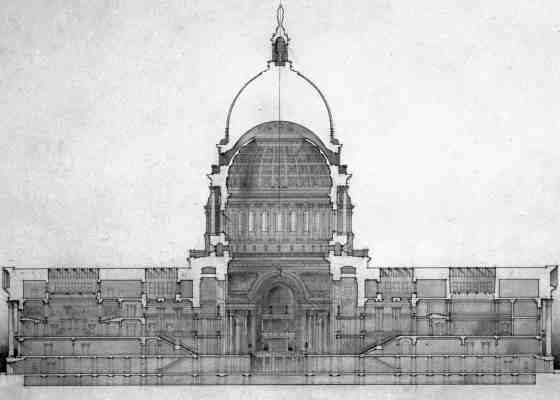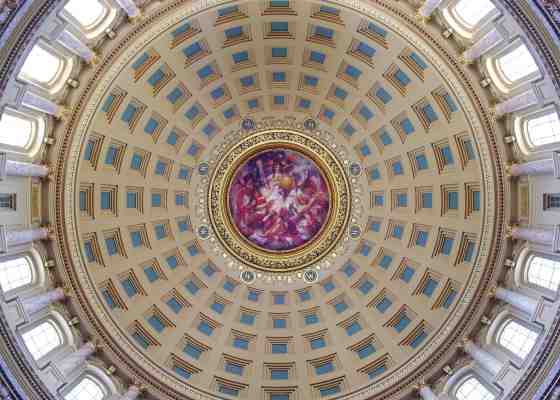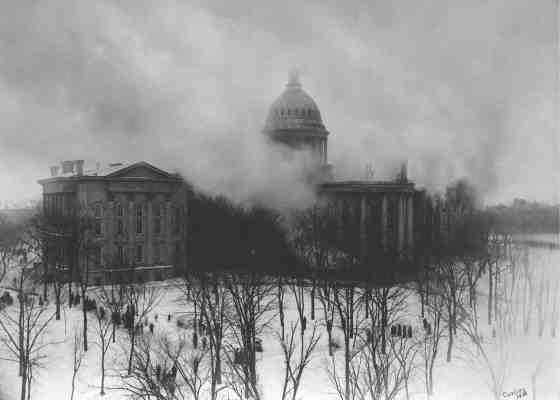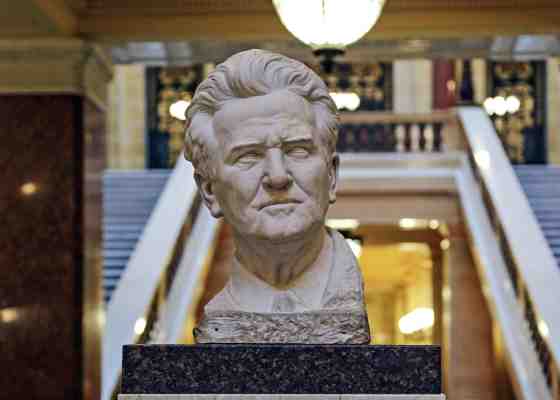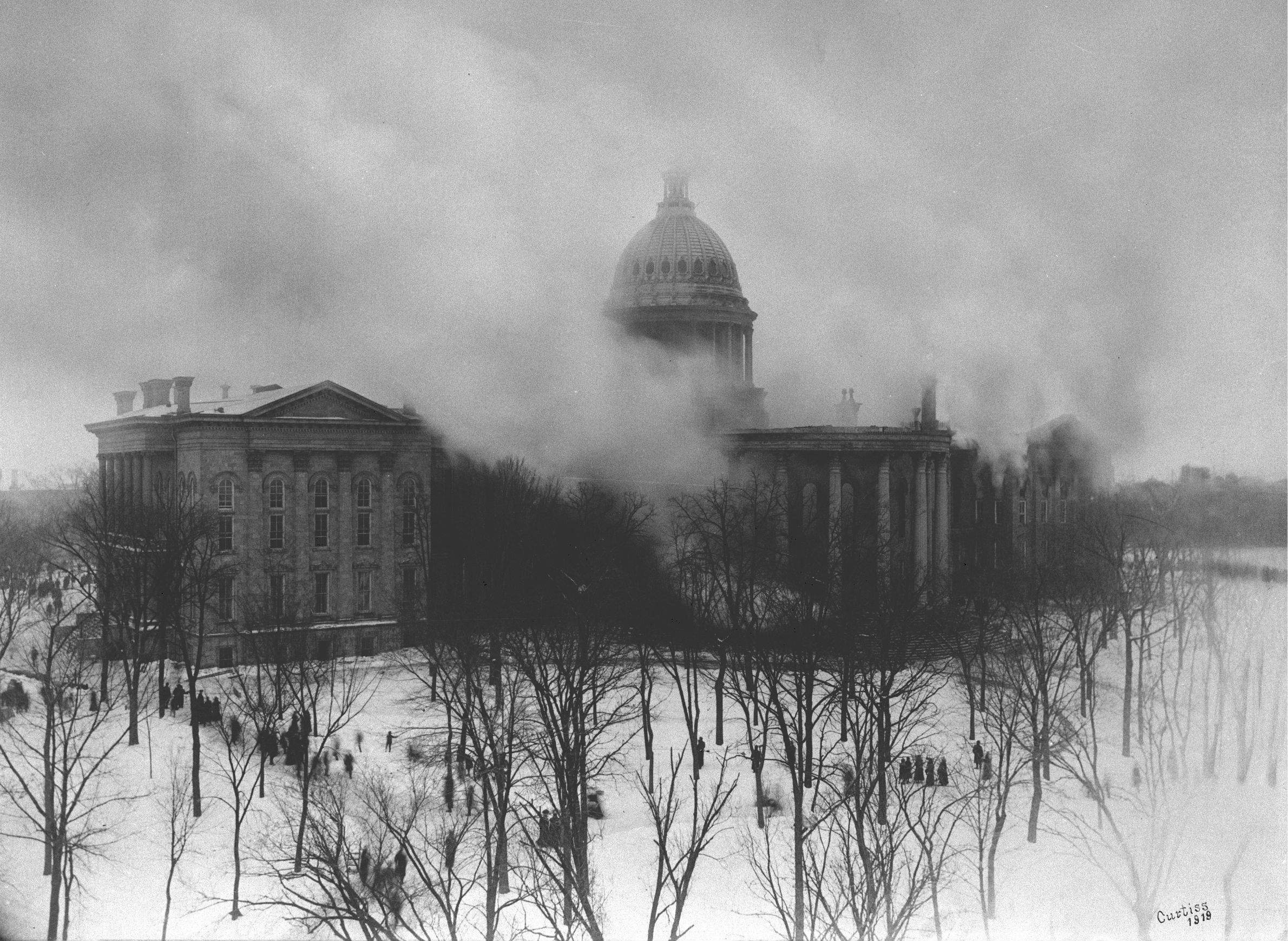
Ambition And Fire Fueled The Growing Scale Of Wisconsin's Capitol Buildings

A building intended to serve as a symbol of freedom and democracy marks its centennial in 2017. But before the Wisconsin State Capitol building rose in the center of Madison, two earlier state houses stood in its place.
Madison was named the state's capital city when Wisconsin Territory's first legislature met in Belmont in 1836. The following spring, a construction crew began work on what would be original capitol building in Madison, explained Wisconsin Historical Society director of programs and outreach Michael Edmonds in a Sep. 19, 2017 presentation at the Wisconsin Historical Museum. The talk, which was recorded for Wisconsin Public Television's University Place, explored the history behind the Badger State's current capitol building and those that previously stood in its place.
The first capitol building in Madison began construction in 1837, with the resulting structure lasting only two decades. The building, Edmonds noted, was not much to be proud of. When heated, its floorboards shrank enough to run a hand between them. In the winter, the building often grew so cold that legislators couldn't take notes. On top of that, the structure was a "fire trap," Edmonds said. In 1859, the legislature decided to appropriate money to fund construction of an entirely new building.
This next capitol was a much more grandiose structure, with wings built on its north and south ends for offices and updated the latest fire suppression technologies. But in a quintessential historical irony, the building's fate was sealed in a gulf of flames.
It was a gas jet, left burning like a night light on the eve of Feb. 27, 1904, that gutted this capitol, Edmonds explained. The water hoses for the building's fire control system, it turned out, were hooked up to the University of Wisconsin’s reservoir on Bascom Hill, which had been drained earlier that day for cleaning, leaving insufficient pressure to move the water along State Street and to the blazing building. About 80 percent of the building was destroyed in the fire, Edmonds said.
Following the fire, the state assembled a bipartisan committee to determine its next steps. The committee's members, as Edmonds explained, decided they "wanted to build a shrine to freedom and democracy." The state would hire architect George B. Post to design a new, even more monumental structure, one that would incorporate numerous works of art to adorn it for posterity. So began the journey to build the capitol building the Wisconsin state legislature calls home today.
Key facts
- While George Post's architectural firm won the bid to build a new capitol building, Madison-based architect Lew Porter supervised the construction while Post was in New York. Porter was known for being incredibly meticulous, and much of the capitol's beauty is attributed to his standard of perfection. One anecdote highlights his attention to detail: One day, when Porter looked at a railing in a stairwell that was meant to be made of solid bronze, he banged on it and then took a hacksaw to the metal, only to find it was not solid. He had the railing removed and sent back for a replacement.
- More than 500 contractors bid on 125 different types of construction jobs for the capitol construction project, ranging from plumbing to painting. For more than a decade, anywhere between 25-40 contractors worked on the building every day. It was the most complicated construction project that state had seen, Edmonds noted.
- Government employees lobbied Lew Porter for bigger offices constantly. Being the high-strung man he was, he lost all patience in 1913 after the state bank examiner deviated from the project plans in effort to secure a new office. Porter waited until the examiner was out of town and then dismantled his office.
- Two people died during the decade-long construction of the new capitol building. One man died while attempting to place an American flag on the building’s highest point during the Fourth of July. The man, who according to an eyewitness report had "filled himself to a good capacity with liquor," lost balance and fell to his death. The second death was that of Dan Logan. When assembling statuary to be placed on the building, a four-ton piece of granite cracked beneath one statue, sending the whole thing down to the street. Logan was killed instantly but the rest of his crew were unharmed.
- The new Wisconsin State Capitol was completed in 1917, but there was no formal celebration to mark its opening until 1965. When construction wrapped up, the United States had just entered World War I, and most Wisconsinites were more concerned with their sons and husbands headed to France than thinking about how to celebrate the building’s completion.
- George Post didn't live to see the completion of the building he designed. Post's two sons took over managing constructing after their father's death in 1913. Lew Porter lived to see the final results of his hard work, but didn't enjoy it for long. Edmonds described how Porter "literally worked himself to death, passing away at age 56 from hypertension and kidney disease just a few months after the building was finished."
Key quotes
- An eyewitness account about Gov. Robert La Follette's response to the 1904 fire: "He ran everywhere through the burning building, directing the work of rescue of valuable records and documents. He helped carry out paintings, furniture, the archives of state government until two citizens took him by the arm and dragged him out of the building. He was completely soaked from head to foot, but he couldn't be put down. After changing into dry clothes, he ran back into the fire."
- On the capitol commission’s vision for a new building: "Most of the people who worked in this commission were old enough to remember coming to Wisconsin and living in log cabins. They'd gone from nothing to being powerful, affluent people who could make decisions about things like the state capitol."
- On the design of the new capitol: "The people who built our capitol didn't want anything to do with Modernism. They wanted the building to look backwards in time. And so the paintings could have been done in 1880 as easily as 1910."
- On the cost of the new capitol: "[Some] legislators were opposed to the cost that such an opulent building would require. Post's fee … was calculated as a percentage of the total project cost, and one senator hinted there as a direct relationship between the architect's specifications for expensive materials and his bank account. Senator Marsh tried to prevent the state from spending enough money to realize Post’s vision, but his proposal was ultimately rejected in a close vote."
- On justification for using expensive materials: "I think we would all agree a hundred years later that if you take away all of those different kinds of gorgeous marble and you take away the painting, you don't really have a shrine to democracy and freedom at all."



